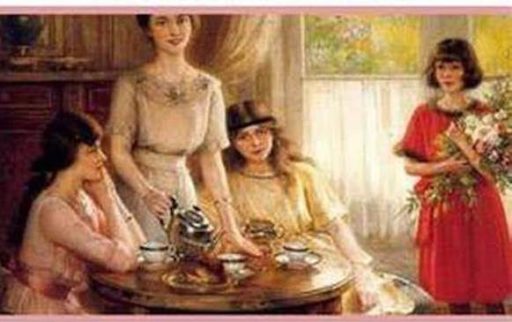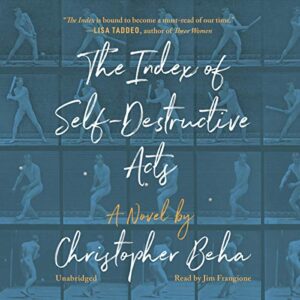What made me want to return to my favorite childhood book, Louisa May Alcott’s Little Women“? Was it when I met my new dental hygienist recently? She introduced herself as “Amy”—which led me to tell her how, as a child, I’d named my newest baby sister “Amy,” because I was reading Little Women when my Mom was pregnant a fourth time.
The longer version is this: As I read Little Women, I noticed how the story’s older three girls had personalities paralleled by my own family. I, the oldest, was like the story’s oldest sister Meg: a bit bossy and “take-charge.” The next oldest sister, Jo, was—amazingly—like my next younger sister Linda: a “tomboy,” as Jo is called in the book and as Linda was referred to at the time. Next in the book comes Beth: sweet and gentle, like my youngest sister Sally. So naturally, when Mom was pregnant again, I declared “If it’s a girl, she has to be named Amy”—and my Mom agreed.
Reporting this to my dental hygienist made me want to re-read Little Women. But to re-read it, I had to buy it. My childhood copies of the entire set of Louisa May Alcott’s novels for children—all bound in bright orange hardcover—had long ago disappeared. So I chose the 1989 Penguin Classics edition, because it has an Introduction by then-prominent feminist literary critic Elaine Showalter.
The novel, written in two Parts in 1868–1869 and set in a New England town, begins during the Civil War—where the girls’ father is off fighting. The March family once was financially comfortable but now is relatively poor.
I was gripped, as always, in re-reading the book—especially Part One, where the four sisters are young. “Pretty” Meg, age sixteen, longs for a life of luxury. Jo, age fifteen, is a “book-worm” and a “tomboy,” impatient with girly things. “A quick temper, sharp tongue, and restless spirit were always getting her into scrapes.” Her longing for her future is to write books. Beth, age thirteen, is painfully bashful, “housewifely,” and loves music, longing for a decent piano. Finally Amy, age twelve, loves drawing and longs to be a great artist.
I found Part One a delight. It follows the girls’ adventures—presented in terms from The Pilgrim’s Progress, which their mother has given them for Christmas. And early on, the novel brings in their next-door neighbor Laurence (or Laurie), a mischievous, fun-loving boy living with his wealthy grandfather. He befriends all the sisters, but Jo especially—since they love horsing around and doing pranks together.
But Part Two became problematic for me—as I could see the sisters getting married off one by one. First Meg, who marries Laurie’s tutor, John, and settles down as a happy housewife and (soon) mother to twins. Then Amy, who continues her drawing, traveling through Europe with her aunt, before marrying Laurie after Jo has refused his proposal. (Trying to soothe his despair at her refusal, Jo tells him: “I can’t love you, Laurie, though we’ll always be friends” and “I don’t believe I shall ever marry; I’m happy as I am, and love my liberty too well to be in any hurry to give it up for any mortal man.”
Beth, who has been increasingly sick throughout the novel, dies at age nineteen. So that left just Jo. I cheered when she rejected Laurie’s proposal. But then, during a stint as governess in New York, she meets the eccentric German immigrant Professor Friedrich Bhaer. He lends her books, teaches her some German, and they become fond of one another. When he later travels to her home to propose to her, she is thrilled and immediately responds “Oh, yes!” (So much for her love of liberty.)
Though I knew this marriage was inevitable, my reading-self rebelled. I moped: Can’t there be any future for females except marriage? (Note: I’ve been happily married for fifty-two years, so I’m not against marriage per se.) At least Jo’s marriage is an unconventional one. Bhaer is much older than Jo, a bit dumpy, very poor, and keeps his belongings in complete chaos—not at all a typical romantic hero.
I knew of course that in nineteenth century America, marriage had to be the fate of every girl—unless she chose to be (horror of horrors) a spinster. So I was delighted to discover, in Elaine Showalter’s superb Introduction to my Penguin Classics edition, that Alcott, unmarried herself, had not wanted to marry off her girls. Showalter quotes a letter Alcott wrote to her uncle when she was starting Part Two: “[P]ublishers are very perverse & wont [sic] let authors have their [sic] way so my little women must grow up & be married off in a very stupid style.”
Showalter (writing, remember, in 1989) then presents the 1970s-1980s feminist critique of Little Women‘s marriages: that the novel is “a capitulation to middle-class ideals of female self-sacrifice.” But Showalter herself demurs:
“Alcott’s novel of female development dramatizes the Transcendentalist dream of sexually egalitarian lives of love and work. Seen in this context, Jo’s literary and emotional career is a happy one, even if it does not conform to our contemporary feminist model of a woman artist’s needs.”
Professor Bhaer, who has given to Jo Shakespeare’s complete works, encourages her intellectual life and, Showalter notes, “understands her need to work.” Though first the couple will pour their energies into running a home and school for “poor, forlorn” boys, the novel hints that eventually Jo will return to writing.
So where does that leave my initial discomfort with the March girls’ marryings? I understand that, in its nineteenth century context, the novel had to marry them off in order to ensure a happy ending—and a saleable book. (And indeed, Little Women‘s closing pages give us a very happy ending. Meg, Jo, and Amy, with their parents and all their children, are gathered at Jo’s home for their yearly apple-picking festivities, rejoicing in the happiness of their lives.) But yet… but yet… thinking back to how women’s lives in the Western world were confined (marriage or the convent) until the Women’s Movement of the 1960s, I can’t help but feel a cringe in my heart for my centuries of fore-mothers.
Peggy Rosenthal has a PhD in English Literature. Her first published book was Words and Values, a close reading of popular language. Since then she has published widely on the spirituality of poetry, in periodicals such as America, The Christian Century, and Image, and in books that can be found here.





